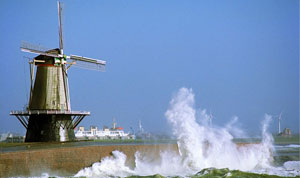USA staat voor energieomslag

Every day, the United States sends $1 billion offshore tofinance its appetite for fossil fuels, a situation recognized fordecades as a threat to national security and energy independence.In 1974, President Nixon was the first in a long line of chiefexecutives to promise reductions in energy from abroad. But thepercentage of U.S. oil imports since then has nearly doubled.
Meanwhile, fossil fuels are the source of the greenhouse gasesblamed for global climate change, an ongoing problem that hasengendered another round of presidential promises. The Obama WhiteHouse recently pledged to reduce such gases 83 percent by 2050,with 2005 as a baseline year.
Reducing dependence on foreign oil and reducing greenhouse gasesare the two major challenges of U.S. energy systems, a visitingfederal energy official told a Harvard audience. To meet thesechallenges, he said, the government’s best role is to mitigate riskin the energy industry and to leverage innovation.
Theoretical physicist Steven Koonin, undersecretary for scienceat the U.S. Department of Energy (DOE), is a rare veteran ofall three spheres in the energy puzzle: academe, business, andgovernment. He has been a professor and provost (CaliforniaInstitute of Technology), an industry chief scientist (BP), andsince last year a federal bureaucrat. At the DOE, Koonin is thescience office’s chief research officer. If you count last year’sAmerican Recovery and Reinvestment Act, he has influence over $100million in funding for energy-related research, loans, and loanguarantees.
Koonin told that the U.S. energy business is complex, operatesby calculating risk and profit in the long term, and approachesinnovation slowly and conservatively. After all, he said, anydecision on technology will create infrastructures – and costs -that last for decades. “The energy business is not simple,” saidKoonin, “and the people in it are not troglodytes.”
Nor are they venture capitalists, said Koonin. In that economicsector, risk and innovation are king, but profits get taken fast.”Exit time” is measured in years, not decades. And average fundingpools – at $150 million – are not enough to prompt scaled-up changein energy systems. “The energy business,” said Koonin, “is not theventure capital business.”
He said government does not have sufficient capital of its own toscale up the needed changes in energy systems, which remain largelyin private hands. Change only will happen if it is profitable ormandated, said Koonin. Government tax credits are powerfulincentives for change, he said. Wind industry installations went upwhen the credits were in place, and slipped when the creditsdisappeared.
Government can also play a big role in the essential steps thatKoonin outlined to improve energy security and reduce greenhousegases. Among them:
- Promote vehicle efficiency. The technology is in hand toincrease the fuel efficiency of American cars by 30 percent, forabout $2,000 a vehicle.
- Conserve. Koonin offered “a sense of what is possible” in oneexample. If all motorists in Texas simply drove at the speed limit,U.S. gas consumption would come down 12 percent.
- Gradually electrify the U.S. vehicle fleet.
- Pursue unconventional fuels.
- Decrease the energy intensity of buildings. Heating, cooling,lighting, and ventilating use 40 percent of U.S. energy.
- Develop “smart grids” for energy transmission and storage. Thatmeans adding digital sensing, measuring, and control devices toincrease reliability and efficiency.
- Set a price for carbon, by cap-and-trade or other means.
- Explore emerging technologies such as concentrated solar powerand carbon capture and storage.
Changing energy systems is difficult and slow, said Koonin, whoreviewed the historical record from 1850 onward. Industry favorschange on “decadal time scales,” he said. The gas-scrubbing systemsfor coal plants, for instance, took 40 years to develop andperfect.
But government can help industry to manage the capital risk ofenergy innovation, said Koonin, and is already acceleratinginvention in what he called “a new set of research structures.”These include a network of national labs, the federal “energy hub”concept, and, for short-term projects, the federal AdvancedResearch Projects Agency – Energy.
Koonin’s decades of research often involved large-scale rapidcomputing, so he sees another bright side to the energy innovationpicture: big and fast computer simulations of the kind that in the1990s were used to replace U.S. nuclear testing. That alone, hesaid, accelerated computer technology by a factor of 10,000. Thesame predictive simulation capability can be focused on U.S. energyissues, said Koonin. “We need to do more of this, faster.”[bron: Harvard Gazette]
Meest Gelezen
Vrouwen houden universiteit draaiende, maar krijgen daarvoor geen waardering
Wederom intimidatie van journalisten door universiteit, nu in Delft
‘Burgerschapsonderwijs moet ook verplicht worden in hbo en wo’
Raad van State: laat taaltoets nog niet gelden voor hbo-opleidingen
Hbo-docent wil wel rolmodel zijn, maar niet eigen moreel kompas opdringen



